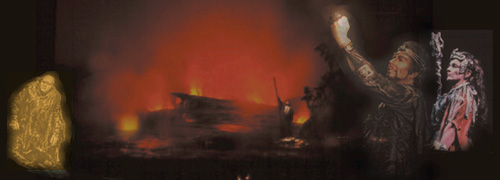| Richard
Wagner's RING
OF
THE NIBELUNG (Der Ring des Nibelungen) |
 |
|
(From photos by Johan Elbers and Winnie Klotz, courtesy of the Metropolitan Opera) |
|
As Wagner began to craft his epic poem about Siegfried's death, he
was stymied in the telling of his story. He found himself having to
keep going back in time to account for the turn of events: how Siegfried
came to be, how Brünnhilde came to love, how the curse fell upon the
RING. In other words, he had a lot of explaining to do. So, borrowing freely from both the Nibelungenlied and the Nordic tales of the Edda and the Volsunga Saga, and exhuming characters (swimming maidens, dwarfs, giants, and dragons) and magical objects from the depths of his imagination, Wagner set upon the most daunting task of his creative life. What emerged was a set of four powerful operatic works now collectively known as The Ring Cycle: Das Rheingold which tells how the Nibelung came to curse the Ring, Die Walküre which tells about how Siegfried came to be and how Brunnhilde came to know about love, Siegfried which tells about his carefree youth in the primeval forest and his first encounter with woman, and Götterdämmerung which tells about Siegfried's betrayal, his vengeful death and the fall of the gods. |
Though Wagner meant for the works to be staged in succession - as a Stage Festival in a theater built to his own innovative specifications - each opera can stand on its own. (As indeed Rheingold and Walküre, which were finished years ahead of the rest, were separately staged though much against the composer's wishes.) Wagner fashioned this masterpiece in a rather roundabout way, first writing the poem from end to beginning and then composing the music from beginning to end.
A youthful thirty-five in 1848 when he wrote the poetry for Götterdämmerung, he completed the text of all the works four years later. But he was a graying sixty-one in 1876 when he finally set the last bar of music for the last of the tetralogy. Siegfried's music proved problematic. A case of composer's block perhaps? But then perhaps not, for it was during this "dry spell" that he wrote his rapturous paean to passion - Tristan und Isolde and his joyful ode to song - Die Meistersinger.
It was in 1876 when Wagner at last realized the ultimate fulfillment of all his dreams for the music-drama, his "Work of Art of the Future."
After nine weeks of rehearsals under his direction, The Ring was staged in its entirety for the first time amid fanfare and celebration, with an orchestra of heroic proportions, in a theatre he could call his very own- the Bayreuth Festspielhaus. There were three complete performances of the Ring Cycle, each taking place over 4 days. Today, Bayreuth - having survived the war and the taint of Nazism- lives as a shrine to the man and his music. For several weeks each summer, the town celebrates the Bayreuth Festival and comes alive with the grandiose sounds of the Wagnerian operas, but most especially the magnificent music of the monumental Ring.
But it is not only in Bayreuth where the Ring Cycle has a home. Ever since its premiere performance in Wagner's time, the world's major opera houses have aspired to stage their own versions of "The Ring." Indeed, it is a measure of an opera company's maturity, of its "having arrived", so to speak. Today, "Ring Cycle" productions are less rare than they used to be; it is no longer unusual to have several "Rings" being staged by various opera companies throughout the world in the same season. The productions range from the avant garde to the traditional/realistic, but invariably play to capacity audiences who come seeking a musical experience like no other. - © GCajipe /FanFaire
Click HERE for a listing of Ring audio and video recordings, or HERE for books on Wagner and the Ring. <<BACK
A WAGNER DISCOGRAPHY SUGGESTED READING CREDITS RING AT THE MET BRÜNNHILDE OF OUR TIME LORD OF THE RING
Design and Original Content: FanFaire LLC © 1997-2009. All rights reserved.
|
|||||||||||||||
EMAIL THIS PAGE!
WAGNER
OPERAS
RING CYCLE
RING DISCS
A WAGNER DISCOGRAPHY
NEW!!!
FanFaire's
WAGNERmania aSTORE
- Books, CDs, DVDs
by and about Wagner
Also, VISIT FanFaire's
GENERAL STORE of MUSIC
***
RING AT THE MET:
Slide Show
About the MET RING
HILDEGARD BEHRENS:
The Brünnhilde of Our Time
JAMES MORRIS:
Lord of the Ring
***
THE SAN FRANCISCO RING:
Stage Sets
VIDEO
AUDIOFILES
AUDIENCE ETIQUETTE
MUSICPLANNER
PRESS ROOM
NEW RELEASES
FOOD & MUSIC
SITE MAP
Sign up:
EMAIL UPDATE
GIVEAWAY!
STORE
USA
Buy sheet music
back to TOP